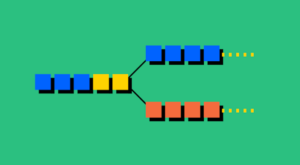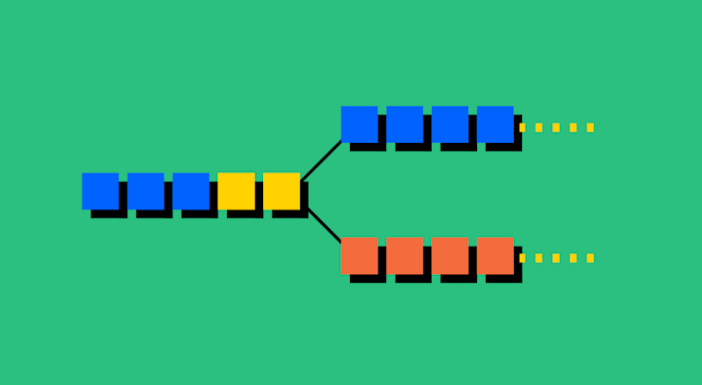Blockchain Forks: What Developers Need to Know
Introduction: Understanding Blockchain Forks
Blockchain forks are a critical concept in the world of cryptocurrency and blockchain technology. A blockchain fork refers to a situation where a blockchain diverges into two separate chains, often leading to the creation of two versions of the same blockchain. Forks can occur for various reasons, ranging from upgrades to disputes within the blockchain community. For developers, understanding blockchain forks is essential, as they can significantly impact the development process, the functionality of the network, and the broader cryptocurrency ecosystem.
In this article, we will explore the different types of blockchain forks, the reasons behind them, their implications for developers, and best practices for managing forks in cryptocurrency development.
1. What Are Blockchain Forks?
A blockchain fork occurs when the rules governing a blockchain network are altered or when two different versions of the blockchain are created. Forks can happen in two main scenarios: software upgrades or disagreements within the community.
Key Characteristics of Blockchain Forks:
- Split in Consensus Rules: A fork occurs when the consensus rules governing the blockchain change or when a new version of the protocol is created. This split results in the creation of two competing chains.
- Compatibility Issues: When a fork occurs, nodes or participants in the network may be unable to agree on which version of the blockchain to follow. This incompatibility can result in a temporary or permanent division in the blockchain.
Types of Blockchain Forks:
- Soft Fork: A soft fork is a backward-compatible upgrade. In a soft fork, only the nodes that upgrade to the new version of the blockchain protocol can participate in validating new transactions. However, older nodes are still able to validate blocks, meaning the network remains functional despite the fork.
- Hard Fork: A hard fork is a non-backward-compatible change. When a hard fork occurs, nodes that continue using the old version of the protocol cannot validate new transactions, and the blockchain essentially splits into two chains. This is typically a more disruptive event than a soft fork.
2. Reasons for Blockchain Forks
Blockchain forks can occur for various reasons, ranging from network upgrades to community disagreements. Understanding these reasons is essential for developers to anticipate potential forks and plan for their impact on the blockchain network.
Common Reasons for Blockchain Forks:
- Protocol Upgrades: Developers may implement changes or improvements to the blockchain protocol, such as adding new features, fixing bugs, or optimizing performance. These changes can result in a soft or hard fork, depending on the nature of the upgrades.
- Disagreements Within the Community: Forks can also occur due to disagreements within the blockchain community about the direction of the project. For example, if a significant portion of the community disagrees with the proposed changes to the protocol, they may decide to create a new blockchain with different consensus rules. This is often seen in contentious forks, such as the split between Bitcoin and Bitcoin Cash.
- Security Vulnerabilities: In some cases, forks are implemented to address security vulnerabilities or prevent attacks. For example, a fork may be initiated to recover from a 51% attack or to patch a critical flaw in the protocol.
- Token or Asset Creation: Forks can also be used to create new cryptocurrencies or tokens. For instance, a hard fork in a cryptocurrency might result in a new coin being created, and holders of the original coin may receive an equivalent amount of the new token.
3. The Implications of Blockchain Forks for Developers
For blockchain developers, forks can have a significant impact on the network and the overall development process. Understanding the implications of forks is essential for minimizing disruption and ensuring that the blockchain remains secure and functional.
Key Implications of Forks:
- Network Stability: Forks can disrupt the stability of the blockchain network. A hard fork, in particular, can cause a division of the network, leading to two separate blockchains. This can result in a loss of consensus, increased risk of attacks, and potential confusion among users.
- Security Risks: Forks can introduce security vulnerabilities. If the fork is not carefully managed, it can leave the blockchain susceptible to attacks or exploits. For example, a poorly executed hard fork could lead to double-spending issues or network splits that compromise security.
- Increased Development Work: Forks can require significant development resources to manage. Developers must ensure that the new version of the blockchain is fully functional and compatible with existing systems. They also need to address any issues arising from the fork, such as ensuring that transactions are properly validated and that the network remains secure.
- Market Uncertainty: Forks can create market uncertainty, particularly in the case of contentious hard forks. When a popular cryptocurrency splits into two separate chains, it can lead to confusion and volatility in the market. Developers need to communicate clearly with the community to manage expectations and minimize market disruption.
- User Experience Impact: Forks can also affect the user experience. Users may find it challenging to keep track of which version of the blockchain they should support or how to manage their tokens on the new chain. Clear communication and user education are essential for minimizing confusion.
4. Managing Blockchain Forks: Best Practices for Developers
For developers, managing blockchain forks is an essential part of maintaining a successful cryptocurrency project. While forks can be disruptive, proper planning and communication can help mitigate their impact and ensure that the network remains secure and stable.
Best Practices for Managing Forks:
- Clear Communication with the Community: One of the most important steps in managing a fork is maintaining open and transparent communication with the community. Developers should inform users of any upcoming forks well in advance, explaining the reasons behind the fork and the potential impact on the network. Community feedback is also important, as it helps ensure that the fork aligns with the needs and desires of users.
- Thorough Testing and Auditing: Before implementing a fork, it is crucial to conduct extensive testing and auditing of the new protocol. Developers should test the fork in a testnet environment to identify potential issues and ensure that the fork does not introduce security vulnerabilities or performance problems.
- Implementing a Clear Migration Path: In the case of a hard fork, developers should provide users with a clear migration path. This includes providing detailed instructions on how users can upgrade to the new blockchain or how they can access their tokens on the new chain. It is also important to ensure that wallets, exchanges, and other platforms are prepared to support the forked chain.
- Ensuring Network Compatibility: To minimize disruption, developers should ensure that the new version of the blockchain is compatible with existing infrastructure. This includes ensuring that nodes, wallets, and smart contracts are updated to support the new protocol.
- Addressing Security Concerns: Developers must prioritize security when managing a fork. This involves implementing security audits, ensuring that the new version of the blockchain is free from vulnerabilities, and safeguarding the network from potential attacks during and after the fork.
- Monitoring the Fork’s Impact: After the fork is implemented, developers should closely monitor the network to ensure that it remains stable and secure. This includes tracking the health of the new blockchain, ensuring that transactions are being processed correctly, and addressing any issues that arise.
5. Famous Blockchain Forks: A Case Study
Several well-known blockchain forks have shaped the cryptocurrency landscape, offering valuable lessons for developers. By examining these cases, developers can better understand the potential risks and rewards of blockchain forks.
Case Study 1: Bitcoin vs. Bitcoin Cash
In 2017, Bitcoin underwent a contentious hard fork that resulted in the creation of Bitcoin Cash (BCH). The fork was driven by disagreements within the Bitcoin community over the scalability of the network and the block size limit. Bitcoin Cash increased the block size limit to allow for more transactions to be processed, whereas Bitcoin retained its original block size. The fork resulted in the division of the Bitcoin community, with some users and miners supporting Bitcoin Cash while others remained with Bitcoin.
Case Study 2: Ethereum and Ethereum Classic
In 2016, Ethereum experienced a hard fork following the DAO hack, which resulted in a major loss of funds for investors. The Ethereum community decided to implement a hard fork to reverse the damage caused by the hack and return the stolen funds to the original investors. However, a portion of the community disagreed with this decision, arguing that the blockchain should remain immutable. As a result, Ethereum Classic (ETC) was born, representing the original Ethereum blockchain, while Ethereum (ETH) continued with the hard forked version.
6. Conclusion: Navigating Blockchain Forks in Cryptocurrency Development
Blockchain forks are an essential aspect of cryptocurrency development, offering both opportunities and challenges. Whether driven by protocol upgrades, community disagreements, or security concerns, forks can significantly impact the stability, security, and usability of a blockchain. Developers must carefully manage forks by prioritizing clear communication, thorough testing, security, and user education. By understanding the causes and implications of blockchain forks, developers can ensure that their projects remain secure, scalable, and successful in the evolving world of cryptocurrency.

Also Read :
